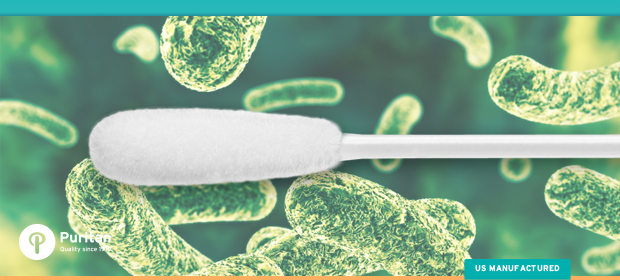
African Journal of Microbiology Research
Vol. 7(31), pp. 4039-4048, 2 August, 2013
Read the Study
One of the most important tools in clinical diagnostics is one of its oldest – the swab. Although simple in appearance, the swab is indispensable to physicians, researchers, clinicians and other laboratory technicians in the collection of viral, bacterial DNA and/or other specimen samples for diagnosis and analysis.
Indeed, two of the biggest indicators of diagnostic sensitivity of a clinical test are the quality and quantity of specimen sample absorbed on and eluted off of the swab head. This sample collection efficiency is highly dependent on physical properties of flocked swab fibers, namely water and protein absorption, Zeta potential (measuring friction capacity), and collection and release recovery.
Fiber composition and flocking technique directly influence a swab’s physical properties and collection efficiency. This is why Puritan Medical Products collaborated with researchers to develop a novel patented fiber design. Unlike any other swabs on the marketplace, whose fibers are composed of a single monopolymer, Puritan’s HydraFlock® and PurFlock Ultra® swabs are composed of a “fiber-within-fiber” microgeometry, with pores that facilitate greater sample absorption, retention and faster release. Our unique flocking process for the HydraFlock® swabs results in split ends that provide even greater surface area for sample retention and friction for faster sample disruption and collection.
One of the most important metrics that Puritan Medical uses in our continued efforts to maintain the highest quality for our array of products is independent testing and analysis, especially in academic laboratories. Not only does this offer us an unbiased assessment of how our products perform relative to our competitors, it also provides ideas about specific improvements and additions for future versions. An exciting new study conducted by researchers at Wake Forest University and published in the African Journal of Microbiology Research examined several key properties of several flocked swabs currently on the market. The superior performance of Puritan’s HydraFlock® swabs was confirmed for properties significant to clinical and diagnostic applications.
Wake Forest University researchers compared water and protein absorption capacity, polystyrene bead capture as a simulation of bacteria and Zeta potential among a collection of swabs, including HydraFlock®, macrofoam, nylon flocked, and rayon flocked swabs provided by Puritan Medical and nylon flocked swabs from Copan Diagnostics, inc. Among the swabs tested, Puritan HydraFlock® swabs exhibited the greatest water and protein absorption percentage by several percentage points, especially when swab head material was accounted for relative to the weight of the whole swab. SEM photomicrographs of the aforementioned swabs dipped in polystyrene beads (a model system that simulated bacteria capture) visually displayed the superiority of the HydraFlock® swabs to capture and retain beads on its greater overall surface area.
Finally, a significant predictor of a drop-off in sample capture and release is Zeta potential, a measurement of repulsion between adjacent, similarly charged particles – essentially the degree of repulsion or attraction between fibers and between fibers and bacteria. The higher the Zeta potential, the higher the degree of internal repulsion. Puritan HydraFlock® swabs exhibited negative Zeta potential values at all pH levels, and a significantly lower overall Zeta potential than all other swabs even at high pH levels, where transport solution might have lost its buffering ability.
The true test of a swab’s utility is how it performs in actual culture studies, utilizing real clinical samples. The researchers measured recovery of all pooled viable bacteria, gram-positive and gram-negative bacteria. Recovery of total bacteria showed a stark difference between the most efficient swabs (HydraFlock®, 69% recovery) and the least efficient (Copan nylon flocked, 53% recovery). Puritan macrofoam swabs exhibited the highest recovery of gram-negative bacteria (86%), while Copan’s nylon flocked swab once again showed the lowest recovery (56%). Finally, the HydraFlock® swabs exhibited a drastically higher retention of gram-positive bacteria (65%) than the lowest performing swab. Additional performance tests with individual bacteria strains (available within the linked study) reinforced the superior overall performance of Puritan’s array of swabs, while also pinpointing the most efficient swabs for clinicians to use based on specific bacteria being collected.
Here at Puritan Medical, we pride ourselves on consistently manufacturing the most state-of-the-art products for our customers, and maintaining the highest quality and performance standards on the marketplace. Independent studies such as the one described here go a long way towards affirming these efforts and the trust that we have built and maintained with our customers. When we say our products exhibit vastly superior performance and utility, we don’t want you to have to take our word for it. We want the raw data to speak for itself.




